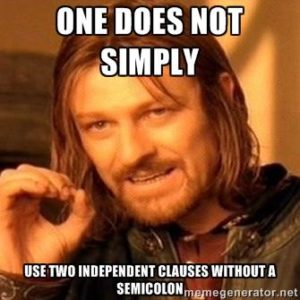Today I am going to introduce two grammatical concepts to you: conjunctive adverbs and prepositional phrases. These are easy enough to understand; in fact, you most likely already use them in your writing without even realizing it!
Being asked to use these can feel like this:

But after you read this blog post you will feel as proud as this dog:
Conjunctive Adverbs:
The job of a conjunctive adverb is to connect two clauses within a sentence to one another. Here is a list of some of the conjunctive adverbs that you may run into:
|
Conjunctive Adverbs |
||
| accordingly also besides consequently conversely finally furthermore hence |
however indeed instead likewise meanwhile moreover nevertheless next |
nonetheless |
You might be feeling like “What!?” but I am going to show you how to use them. As I said before, the job of a conjunctive adverb is to connect two clauses of a sentence to one another. It should look like this:
Clause 1; Conjunctive Adverb, Clause 2
Please note that you MUST use a semicolon after clause one.
Here is are some example sentences that uses conjunctive adverbs:
I would really like to go shopping; however, I do not have any money. #collegeprobs
I need to harvest all these turnips; furthermore, the cows need to be milked. #farmerlife
Prepositional Phrases:
Another tricky grammatical concept is the prepositional phrase. You might be trying to figure out what a prepositional phrase is, furiously googling it like this cat, but I’ll save you some time.
A prepositional phrase is a preposition, its object, and any modifiers between them. For example: through the looking glass; “through” is the preposition, “looking glass” is the object, and “the” is the modifier.
A preposition is a word that indicates location, such as in, around, or through. The object of a preposition is the noun or pronoun that the preposition is talking about. A modifier is a word, phrase, or clause that provides description in a sentence. Prepositional phrases generally look like this:
Preposition + Noun, Pronoun, or Clause
For example: over budget; “over” is the preposition and “budget” is the noun.
Preposition + Modifier + Noun, Pronoun, or Clause
For example: through the spooky forest; “through” is the preposition, “the spooky” is the modifier, and “forest” is the noun.
Here are a couple example sentences with prepositional phrases in them:
Amy can’t move because of all the squats she did at the gym yesterday. #beastmode
Jessie learned how to use prepositional phrases in the Writing Resource Center. #GOALS
Now, go and write using ALL the conjunctive adverbs and prepositional phrases!
And remember, if you need more clarification or just want to practice using conjunctive adverbs and prepositional phrases in your writing, stop by the Writing Resources Center! Our tutors would love to help you learn to use these concepts.
— Melissa
Resources for more help with conjunctive adverbs:
http://www.chompchomp.com/terms/conjunctiveadverb.htm
https://writing.wisc.edu/Handbook/ConjAdv.html
http://www.niu.edu/wac/archives/files/conjadv.html
Resources for more help with prepositional phrases:
http://www.chompchomp.com/terms/prepositionalphrase.htm



